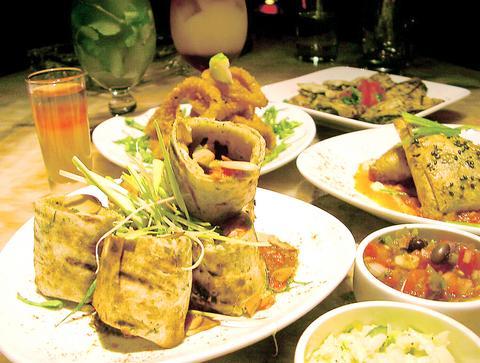If you're not a fan of Latin music or a good salsa dancer, there are still plenty of reasons to visit Barrio, the new Latin bar in Taipei: the food for example. At Barrio there are no microwave pizzas or cold snacks, and no burritos or enchiladas, the flour for which comes from Taipei's Florida bakery.
Barrio's kitchen offers a third choice, what chef Tomer Feldman calls "fusion Latino food." On the menu you see interesting combinations such as Latino sushi or Italian-styled quesadillas.
"I wanted people to see the unexpected when they come here, and to have some new impressions about Latin food," said Israeli-born Feldman. Having been a chef at up-scale New York restaurants for 12 years, such as Italian restaurant Puccini in upper West and Bari Cafe in Soho, Feldman said he's experienced with Latin food. Creating variations and fusion seems to interest him most. In Taiwan, his previous job was a chef at Rendezvous, the first fusion Italian restaurant in Taipei.

PHOTO: YU SEN-LUN, TAIPEI TIMES
Latino sushi is actually tortilla rolls, like burritos, but chopped in slices which resemble sushi. Goat cheese and roasted pepper roll is the best-selling item so far among the Latino sushi dishes. Traditionally, Mexican burritos comprise wrapped rice and beans, thus giving a heavy feel after a meal. In Feldman's recipes the fillings are much lighter and healthier, good for dancing, perhaps?
One more reason to eat at Barrio is you get to taste different kinds of dipping sauces with just one tapas dish. According to Feldman having different dipping sauces in one dish is common to Israeli restaurants. These home-made sauces have, again, each been infused with unusual ingredients. Salsa sauces are added to beans and toasted with ground cumin seeds. Coleslaw is added to jalapenos for a spicy coleslaw, or "fusion kimchi."
In March, Barrio's kitchen will present main course dishes such as burritos, enchiladas and tacos. "But again, they will be unconventional Latin main courses," Feldman said.

On April 26, The Lancet published a letter from two doctors at Taichung-based China Medical University Hospital (CMUH) warning that “Taiwan’s Health Care System is on the Brink of Collapse.” The authors said that “Years of policy inaction and mismanagement of resources have led to the National Health Insurance system operating under unsustainable conditions.” The pushback was immediate. Errors in the paper were quickly identified and publicized, to discredit the authors (the hospital apologized). CNA reported that CMUH said the letter described Taiwan in 2021 as having 62 nurses per 10,000 people, when the correct number was 78 nurses per 10,000

As we live longer, our risk of cognitive impairment is increasing. How can we delay the onset of symptoms? Do we have to give up every indulgence or can small changes make a difference? We asked neurologists for tips on how to keep our brains healthy for life. TAKE CARE OF YOUR HEALTH “All of the sensible things that apply to bodily health apply to brain health,” says Suzanne O’Sullivan, a consultant in neurology at the National Hospital for Neurology and Neurosurgery in London, and the author of The Age of Diagnosis. “When you’re 20, you can get away with absolute

May 5 to May 11 What started out as friction between Taiwanese students at Taichung First High School and a Japanese head cook escalated dramatically over the first two weeks of May 1927. It began on April 30 when the cook’s wife knew that lotus starch used in that night’s dinner had rat feces in it, but failed to inform staff until the meal was already prepared. The students believed that her silence was intentional, and filed a complaint. The school’s Japanese administrators sided with the cook’s family, dismissing the students as troublemakers and clamping down on their freedoms — with

As Donald Trump’s executive order in March led to the shuttering of Voice of America (VOA) — the global broadcaster whose roots date back to the fight against Nazi propaganda — he quickly attracted support from figures not used to aligning themselves with any US administration. Trump had ordered the US Agency for Global Media, the federal agency that funds VOA and other groups promoting independent journalism overseas, to be “eliminated to the maximum extent consistent with applicable law.” The decision suddenly halted programming in 49 languages to more than 425 million people. In Moscow, Margarita Simonyan, the hardline editor-in-chief of the